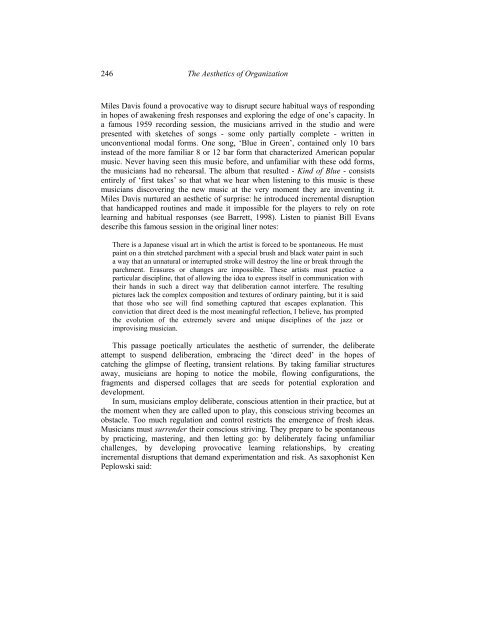Cultivating aesthetics - iSites
Cultivating aesthetics - iSites
Cultivating aesthetics - iSites
Create successful ePaper yourself
Turn your PDF publications into a flip-book with our unique Google optimized e-Paper software.
246<br />
The Aesthetics of Organization<br />
Miles Davis found a provocative way to disrupt secure habitual ways of responding<br />
in hopes of awakening fresh responses and exploring the edge of one’s capacity. In<br />
a famous 1959 recording session, the musicians arrived in the studio and were<br />
presented with sketches of songs - some only partially complete - written in<br />
unconventional modal forms. One song, ‘Blue in Green’, contained only 10 bars<br />
instead of the more familiar 8 or 12 bar form that characterized American popular<br />
music. Never having seen this music before, and unfamiliar with these odd forms,<br />
the musicians had no rehearsal. The album that resulted - Kind of Blue - consists<br />
entirely of ‘first takes’ so that what we hear when listening to this music is these<br />
musicians discovering the new music at the very moment they are inventing it.<br />
Miles Davis nurtured an aesthetic of surprise: he introduced incremental disruption<br />
that handicapped routines and made it impossible for the players to rely on rote<br />
learning and habitual responses (see Barrett, 1998). Listen to pianist Bill Evans<br />
describe this famous session in the original liner notes:<br />
There is a Japanese visual art in which the artist is forced to be spontaneous. He must<br />
paint on a thin stretched parchment with a special brush and black water paint in such<br />
a way that an unnatural or interrupted stroke will destroy the line or break through the<br />
parchment. Erasures or changes are impossible. These artists must practice a<br />
particular discipline, that of allowing the idea to express itself in communication with<br />
their hands in such a direct way that deliberation cannot interfere. The resulting<br />
pictures lack the complex composition and textures of ordinary painting, but it is said<br />
that those who see will find something captured that escapes explanation. This<br />
conviction that direct deed is the most meaningful reflection, I believe, has prompted<br />
the evolution of the extremely severe and unique disciplines of the jazz or<br />
improvising musician.<br />
This passage poetically articulates the aesthetic of surrender, the deliberate<br />
attempt to suspend deliberation, embracing the ‘direct deed’ in the hopes of<br />
catching the glimpse of fleeting, transient relations. By taking familiar structures<br />
away, musicians are hoping to notice the mobile, flowing configurations, the<br />
fragments and dispersed collages that are seeds for potential exploration and<br />
development.<br />
In sum, musicians employ deliberate, conscious attention in their practice, but at<br />
the moment when they are called upon to play, this conscious striving becomes an<br />
obstacle. Too much regulation and control restricts the emergence of fresh ideas.<br />
Musicians must surrender their conscious striving. They prepare to be spontaneous<br />
by practicing, mastering, and then letting go: by deliberately facing unfamiliar<br />
challenges, by developing provocative learning relationships, by creating<br />
incremental disruptions that demand experimentation and risk. As saxophonist Ken<br />
Peplowski said:
















